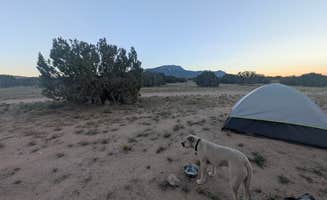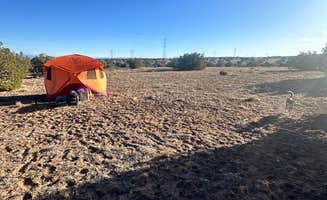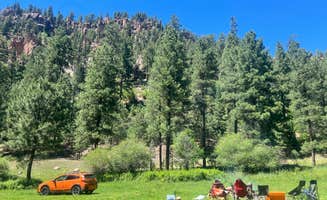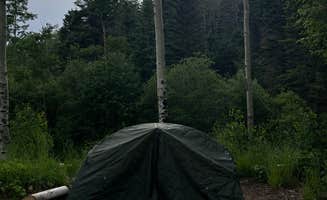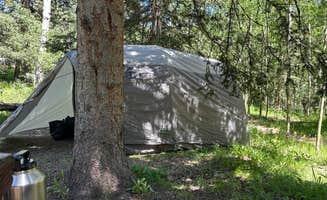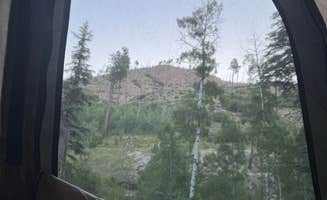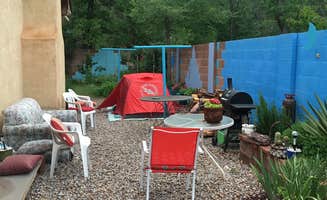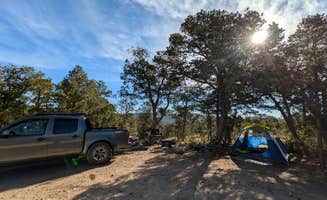Tent camping near Cochiti Lake occurs at elevations between 5,400-8,000 feet, resulting in temperature swings of 30-40°F between day and night. The desert-pine transition zone receives approximately 14 inches of annual rainfall, mostly during summer monsoon season from July through September. Roads leading to dispersed camping areas often become impassable after rainfall, with some sites remaining muddy for 2-3 days following storms.
What to do
Hiking at American Springs: Access multiple trails within 1-2 miles of camp with moderate elevation gain of 500-1,000 feet. American Springs offers views of Los Alamos and snow-capped peaks. "Elk grazing below were the cherry on top," reports Matthew N., who appreciated the "peaceful view down the canyon."
Winter camping at Big Tesuque: Experience snow camping at 10,000 feet elevation with significantly fewer visitors from December through March. Jorge G. notes, "Road is paved all the way and regularly plowed during the cold seasons. I'm sure this is very busy during the warm seasons but we had the place to ourselves during the week in early December."
Stream exploration: Wade through shallow brooks during summer months when water levels drop to 3-5 inches. "There are two creeks running along either side," shares Megan C. about Big Tesuque Campground, making it ideal for cooling off when temperatures reach 85-90°F.
What campers like
Seasonal variation: Fall brings changing aspen colors while winter offers solitude at higher elevations. "Chilly in mid October visit. Aspens are gorgeous on the drive up," reports Em X K. about Aspen Basin Campground.
Privacy levels: Campsites spaced 50-100 yards apart at most dispersed locations allow for quiet camping experiences. "There are multiple site identified with lot signs and fire rings. Some of the spots are easier to access than others," explains Lily H. about dispersed camping off FS 542, where "activities ended around 7 and made for a peaceful night."
Night sky viewing: Minimal light pollution allows for stargazing at most sites from 9pm-5am. "Very peacefull and great night stars," reports Joseph W., who found camping near Ojito Wilderness provided excellent astronomy opportunities with "3 to 4 bars of Verizon cell service" for those needing connectivity.
What you should know
Vehicle requirements: Most dispersed sites require 6-8 inches of ground clearance. "You definitely need something high-clearance with 4x4 as there are large ruts on either side, potholes, and large rocks," warns Ashley T. about camping off Forest Service Road 542.
Wildlife encounters: Bears, coyotes, and elk frequent camping areas within the Santa Fe National Forest. "There were coyotes around," notes Matt M., who stayed at dispersed camping near FS 542 and recommends storing food properly.
Temperature considerations: Plan for freezing nighttime temperatures year-round at elevations above 7,500 feet. "It gets cold at night since at approximately 8,000 elevation," cautions Maeci W. at Road 378 near Fenton Lake, where summer days can reach 80°F while nights drop to 40°F.
Tips for camping with families
Stream access sites: Choose locations with shallow water features for children's entertainment. Bailey B. found that at Big Tesuque Campground, being "next to a little river" provided natural play areas while sites remained "so spaced out."
Consider altitude effects: Children may experience mild altitude symptoms at elevations above 7,000 feet. "I developed a heart condition which limits my abilities most days and the ease of access to these sites and close parking is great," shares Luke M., highlighting Big Tesuque's accessibility for those with physical limitations.
Private backyard camping: For families wanting facilities with tent camping experience, consider urban options. "Airbnb for tent camping, overnight parking for van camping, full access to home amenities," describes Jayston M. about Mother Bosque Gardens, an unconventional option just 45 minutes from Cochiti Lake.
Tips from RVers
Size limitations: Few dispersed sites accommodate trailers longer than 20 feet or RVs taller than 10 feet. "We stayed here with our pull behind trailer and I do not recommend doing what we did. It's very hard to get up to the actual spots," cautions Ashley T. about camping off FS 542.
Arrival timing: Reach campgrounds before 4pm to secure sites and navigate rough roads safely. "Plan to arrive well before dark, as it's very hard to find the rings in the dark," advises a camper who found nighttime navigation challenging at dispersed sites near Cochiti Lake.
Winter accessibility: Most RV sites above 7,000 feet close from November through April due to snow and ice. Those remaining open require chains and four-wheel drive vehicles for towing.


